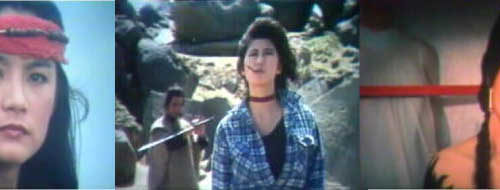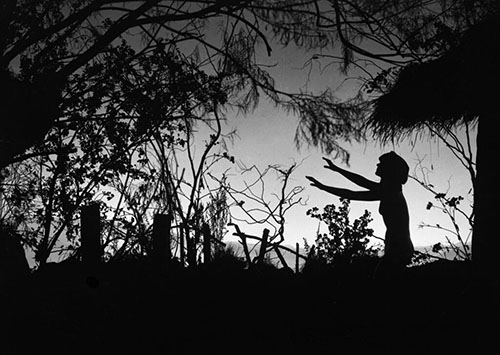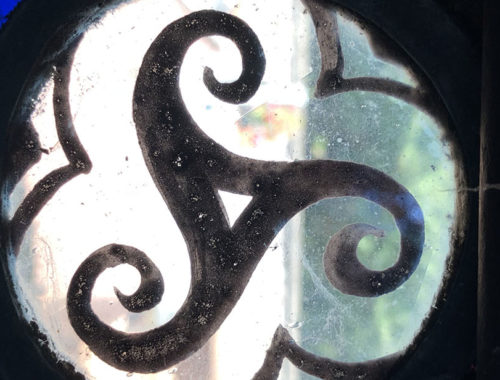St. John’s Eve in New Orleans
Ask a group of Pagans what the most important time of the year is, and they’ll usually answer “Samhain” or “Beltaine.” But ask someone from New Orleans, and they’ll most likely tell you that in the Big Easy, the high point of the year for Christians, Pagans and Voudou practitioners alike is at Midsummer—June 23, to be precise—St. John’s Eve.*
As its residents like to say, New Orleans is a “gumbo” of cultures rather than a melting pot. The spiritual practices of its waves of immigrants have blended into a spicy stew of traditions that compliment each other while maintaining their own flavor. Nowhere is this more evident than in the New Orleans version of St. John’s Eve, an eclectic mix of Pagan, Catholic, and Voudou beliefs with a pinch of ceremonial magic thrown in for good measure. It is a festival that transcends race and class and celebrates transition, purification, spirit contact, and the magic of the snake.
History of St. John’s Eve
Midsummer, in one form or another, has long been celebrated in New Orleans. Early European colonists to the New Orleans area reported seeing Native Americans performing ceremonies and burning bonfires along the shores of the Mississippi river, Lake Ponchartrain and the bayous during this time of the year. These annual festivities brought together representatives of many of the neighboring tribes, including the Choctaw and Houma. As time progressed, New Orleans was settled by European immigrants, including the French, Spanish, and Germans, and by their African slaves. The Europeans naturally brought Catholicism and their Pagan traditions with them, and the slaves contributed African and Voudou ceremonies. Eventually, the modern St. John’s Eve evolved from these roots.
St. John’s Eve was loaded with symbolism for the French, whose culture permeates that New Orleans gumbo. Midsummer was a fire festival in much of old Europe—a celebration of the longest day of the year, where the grain was ripening, the light eventually gave way to the darkness, and the sun king gave up his reign to his successor. In some areas, barrels were lit and rolled down hills to represent the sun. In others, including France, ceremonial “kings” relinquished their crowns in a mock death, symbolic of transformation, the peak of the sun’s cycle and the turning of the wheel. It is said that King Louis XIV participated in this rite himself, and was the last actual French king to do so. According to Sir James Frazer, in The Golden Bough:
The French kings often witnessed these spectacles and even lit the bonfire with their own hands. In 1648 Louis the Fourteenth, crowned with a wreath of roses and carrying a bunch of roses in his hand, kindled the fire, danced at it and partook of the banquet afterwards in the town hall. But this was the last occasion when a monarch presided at the midsummer bonfire in Paris.
It should be noted that Frazer believed that the European Midsummer bonfires were more about protection from Witches than the transition of kings, and that another account says that Louis was the king who banned the practice of Midsummer fires, but regardless, Louis’ participation seems appropriate. He was called the “Sun King” because of his opulent reign, his self-identification with the Sun god Apollo, and, interestingly, a role he danced in a ballet. On top of that, St. John was the patron saint of the French kings, and therefore Louis XIV’s patron, so Louis was a living bridge between the Pagan and Catholic origins of this feast day.
The Secret Societies
Perhaps because of the city’s “French connection,” St. John’s Eve, the feast of St. John the Baptist, was the first Catholic holiday celebrated in New Orleans. St. John, who introduced the transformative rite of baptism into what was to become Christianity, was beheaded after giving his healing gift to the people, so he is yet another archetypal “sacred king.” He is also the patron saint of the Masons, Oddfellows, and other secret societies that were the philosophical descendants of the French Order of the Knights Templar. These secret societies were very influential and even beloved in eighteenth and ninteenth century New Orleans, and they were involved in all levels of the political and social fabric of the city. Their influence can still be seen today in the many cemeteries, hospitals, halls and charities that they either founded or that bear names, so it seems natural that the feast day of their patron would become an important part of the city’s culture.
Voudou Influences
Although the influence of the secret societies was integral to the cultural and structural development of the city, New Orleans is better known for its Voudou. Over the years, Voudou has had a huge impact on the spirit and traditions of the Big Easy, especially the celebration of St. John’s Eve. One could argue that Voudou is the broth in which the many seasonings of the city’s cultural gumbo simmer together.
Voudou is a mixture of traditional African and New World practices. New Orleans Voudou practitioners are particularly known for assimilating bits and pieces from other traditions and religions into their own rites. Both New Orleans and Haitian Voudou use symbolism from the Masons and ceremonial magic, as can be seen in the veves (symbols of ancestor spirits, or loas) used to attract the spirits.
In New Orleans, the Voudou practitioners also incorporated Catholic practices, such as correlating each of the Voudou ancestor spirits with a saint. Marie Laveau, the famous nineteenth-century Voudou priestess/queen, was a devout Catholic who reportedly attended mass daily. The people who attended the rites were as eclectic as the rites themselves. Voudou ceremonies held in places like Congo Square (which is now a part of Armstrong Park, on infamous North Rampart Street) were in Marie’s time and are now attended by people of a variety of races, cultures, and social classes, although the scandalous reputation of the rites in centuries past meant that many participated “on the sly.”
St. John’s Eve with Marie Laveau
According to newspaper and other accounts from the time of Marie Laveau’s “reign,” on St. John’s day in New Orleans the Voudou practitioners would congregate on the banks of the Mississippi or Lake Ponchartrain. Marie Laveau, with her “king” and “valet” (seconds) would arrive on a barge of fire. There was a rope tied to the barge, and people on the banks would pull her back and forth for effect. Once she had landed, the participants would celebrate with dance, singing, and food, and sometimes weddings or initiations. The Voudou priestess would also perform divination, because in New Orleans Voudou St. John’s Eve, like Halloween, is a time when the veil is thin and the spirits of the dead hover close to the earth.
The congregants would also build energy and intent by chanting “We’re going to die in this lake!” over and over again in Creole, until finally, at midnight, they rushed into the water for purification and to simulate death and rebirth—a transition with echoes of baptism, the succession of kings, and the turning of the wheel.
Marie Laveau was known for dancing with a snake in her St. John’s Eve rituals. The snake was named Zombi, after La Gran Zombi, the main ancestral spirit of New Orleans. Zombi meant “god” or “spirit force” in the Congo, where many New Orleans Voudou traditions have their roots. The loa of Voudou (more commonly called ancestor spirits in New Orleans) are more like intercessors than gods. They are the spirits of powerful people who have died. After the death of powerful or important people, petitioning and “feeding” their spirits through ritual—and sometimes sacrifice—along with the power of collective belief, elevates them to become intercessors between humans and God.
In New Orleans Voudou, after Papa Legba, the opener of the gates, has been petitioned to open the doors to the spirit world, La Gran Zombi frequently serves as a “channel” to the other ancestral spirits with whom practitioners want to communicate for the purposes of worship, divination, and magic.
The Snake and the Water
The snake and water are very prevalent in New Orleans. The city rests at the end of the Mississippi, which is snake and water in one. Both snakes (which shed their skins), and water (which erodes mountains and valleys), are symbolic of the transformation inherent in the celebration of St. John’s Eve. The oroboros—the circle created by the body of a snake biting its own tail—also represents the cycle of death and rebirth. When Marie Laveau danced with Zombi she wasn’t just putting on a show—she was holding a physical representation of the ancestor spirits and of the changes wrought by participation in the rite. The snake is considered part of La Gran Zombi, as are the alligators (the dragons) found in the Louisiana bayous.
As for the water, in Africa, the river was a common point of worship between tribes or groups, just as it was when the Louisiana Native Americans, and later the Voudou practitioners, gathered beside the Mississippi to celebrate. It is still the common spiritual point in New Orleans today, and a potent conduit of energy.
St. John’s Eve in Modern New Orleans
The modern New Orleans, St. John’s Day celebrations look quite a bit like the rituals of Marie Laveau, with bonfires, singing, dancing, and lots of food. My friend Mary, a New Orleans historian, shared with me her favorite traditional St. John’s Eve verse, which still seems relevant for describing St. John’s Eve celebrations of today:
Green is gold
Fire is wet
The future is told
And dragons met.
Around St. John’s Eve, the sun begins to turn the green wheat to gold, the fires are lit on the water, people gather for divination and communion with the spirits, and they experience the power of the snake (or dragon or alligator, if they’re not careful). Many New Orleans Voudou practitioners, both from Marie Laveau’s time and now, believe that since the city is below sea level and at the end of the Mississippi, it “holds” and condenses all of the magical energy that flows down the river. According to some, the collected power of the city draws people in, and is largely responsible for the prevalence of spiritual and occult activity there. In fact, New Orleans, resting at the tail of the Mississippi, is a bit like the collection of kundalini energy at the base of the spine.
But the power can overwhelm, so the fires, dancing, and ritual bath of St. John’s Eve are very important in order to scrape off all the excess energy and begin anew. These days, however, the Mississippi collects pollutants and garbage as well as energy, so people are a little reticent to run into the water. I’m told, however, that most people believe that a little dancing and feasting and a ritual head wash will do.
*Much of the information in this article comes from an interview/conversation and brain-picking session I had with my friend Mary Millan, aka “Bloody Mary,” New Orleans historian and poet-priestess. Mary is an amazing storyteller with an extensive knowledge of New Orleans history—mundane, spiritual and/or spooky. If you’re interested in the ghosts, vampires, Voodoo, history and stories of the Big Easy, please visit her website.




